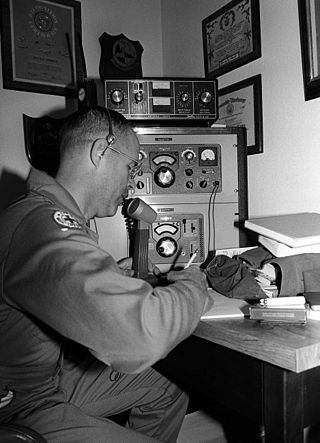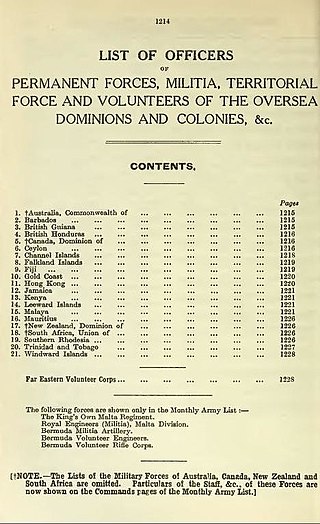
The British Army is the principal land warfare force of the United Kingdom, British Overseas Territories and Crown Dependencies, a part of the British Armed Forces along with the Naval Service and the Royal Air Force. As of 1 January 2024, the British Army comprises 75,166 regular full-time personnel, 4,062 Gurkhas, 26,244 volunteer reserve personnel and 4,557 "other personnel", for a total of 110,029.

The British Armed Forces are the military forces responsible for the defence of the United Kingdom, its Overseas Territories and the Crown Dependencies. They also promote the UK's wider interests, support international peacekeeping efforts and provide humanitarian aid.

The Army Reserve is the active-duty volunteer reserve force of the British Army. It is separate from the Regular Reserve whose members are ex-Regular personnel who retain a statutory liability for service. The Army Reserve was known as the Territorial Force from 1908 to 1921, the Territorial Army (TA) from 1921 to 1967, the Territorial and Army Volunteer Reserve (TAVR) from 1967 to 1979, and again the Territorial Army (TA) from 1979 to 2014.

The Defence Forces are the armed forces of Ireland. They encompass the Army, Air Corps, Naval Service, and Reserve Defence Forces.

Auxiliaries are support personnel that assist the military or police but are organised differently from regular forces. Auxiliary may be military volunteers undertaking support functions or performing certain duties such as garrison troops, usually on a part-time basis. Unlike a military reserve force, an auxiliary force does not necessarily have the same degree of training or ranking structure as regular soldiers, and it may or may not be integrated into a fighting force. Some auxiliaries, however, are militias composed of former active duty military personnel and actually have better training and combat experience than their regular counterparts.

His Majesty's Naval Service is the United Kingdom's naval warfare and maritime service. It consists of the Royal Navy, Royal Marines, Royal Fleet Auxiliary, Royal Naval Reserve, Royal Marines Reserve and Naval Careers Service. The Naval Service as a whole falls under the command of the Navy Board, which is headed by the First Sea Lord. This position is currently held by Admiral Sir Ben Key. The Defence Council delegates administration of the Naval Service to the Admiralty Board, chaired by the Secretary of State for Defence.

A military reserve force is a military organization whose members (reservists) have military and civilian occupations. They are not normally kept under arms, and their main role is to be available when their military requires additional manpower. Reserve forces are generally considered part of a permanent standing body of armed forces, and allow a nation to reduce its peacetime military expenditures and maintain a force prepared for war. During peacetime, reservists typically serve part-time alongside a civilian job, although most reserve forces have a significant permanent full-time component as well. Reservists may be deployed for weeks or months-long missions during peacetime to support specific operations. During wartime, reservists may be kept in service for months or years at a time, although typically not for as long as active duty soldiers.
The Royal Air Force Volunteer Reserve (RAFVR) was established in 1936 to support the preparedness of the U.K. Royal Air Force in the event of another war. The Air Ministry intended it to form a supplement to the Royal Auxiliary Air Force (RAuxAF), the active reserve for the RAF, by providing an additional non-active reserve. However during the Second World War the high demand for aircrew absorbed all available RAuxAF personnel and led the RAFVR to quickly become the main pathway of aircrew entry into the RAF. It was initially composed of civilians recruited from neighbourhood reserve flying schools, run by civilian contractors with largely RAF-trained flying instructors as well as other instructors in related air war functions, such as observers and wireless operators.

The Territorial and Reserve Forces Act 1907 was an Act of the Parliament of the United Kingdom that reformed the auxiliary forces of the British Army by transferring existing Volunteer and Yeomanry units into a new Territorial Force (TF); and disbanding the Militia to form a new Special Reserve of the Regular Army. This reorganisation formed a major part of the Haldane Reforms, named after the creator of the Act, Richard Haldane.

The Sri Lanka Volunteer Naval Force (SLVNF) is the active-duty volunteer reserve force of the Sri Lanka Navy. The SLVNF, which consists of the volunteer force and the volunteer reserve is separate from the Regular Naval Force, which consists of the Regular Force consisting of professional naval officers and sailors, and its Regular Reserve, which comprises personal who have a mobilization obligation following their service in the regular force.

The Volunteer Force was a citizen army of part-time rifle, artillery and engineer corps, created as a popular movement throughout the British Empire in 1859. Originally highly autonomous, the units of volunteers became increasingly integrated with the British Army after the Childers Reforms in 1881, before forming part of the Territorial Force in 1908. Most of the regiments of the present Army Reserves Infantry, Artillery, Engineers and Signals units are directly descended from Volunteer Force units.

The Special Reserve was established on 1 April 1908 with the function of maintaining a reservoir of manpower for the British Army and training replacement drafts in times of war. Its formation was part of the military reforms implemented by Richard Haldane, the Secretary of State for War, which also created the Territorial Force. Haldane originally intended that the Militia would provide the reserve, but opposition from its representatives forced him to abolish it and create the Special Reserve instead. Only 60 per cent of the Militia transferred into the new reserve, and it was consistently under strength, particularly in officers. Reservists enlisted for a six-year term of service, and had to undergo six months of basic training on recruitment and three to four weeks training annually.

The British Colonial Auxiliary Forces were the various military forces of Britain's colonial empire which were not considered part of the British military proper.

The Haldane Reforms were a series of far-ranging reforms of the British Army made from 1906 to 1912, and named after the Secretary of State for War, Richard Burdon Haldane. They were the first major reforms since the "Childers Reforms" of the early 1880s, and were made in the light of lessons newly learned in the Second Boer War.

The Reserve Forces and Militia Act 1898 was an Act of the Parliament of the United Kingdom, which came into force in 1898.
The reserve components of the United States Armed Forces are military organizations whose members generally perform a minimum of 39 days of military duty per year and who augment the active duty military when necessary. The reserve components are also referred to collectively as the National Guard and Reserve.
The Volunteer Reserves are the British Armed Forces voluntary and part-time military reserve force. Unlike the Regular Reserve, the Volunteer Reserves do not consist of ex-Regular personnel who remain liable to be re-called for military service. Instead, the Volunteer Reserves consists of civilian volunteers who routinely undergo training and military operations alongside the Regular military. The Volunteer Reserves serve under a fixed-term reserve contract and provide "highly trained" military personnel integrated with their Regular counterparts, on operations both at home and overseas. For example, almost every major military operation has seen the deployment of Army Reservists alongside the Regular British Army. Volunteer Reserves are allowed to use the post-nominal letters VR after 10 years of service.
The Regular Reserve is the component of the military reserve of the British Armed Forces whose members have formerly served in the "Regular" forces. The Regular Reserve largely consists of ex-Regular personnel who retain a statutory liability for service and are liable to be recalled for active military duty "in case of imminent national danger or great emergency". It also consists of a smaller number of ex-Regulars who serve under a fixed-term reserve contract and are liable for reporting, training and deploying on operations.

Until 1689, mutiny was regulated in England by Articles of War instituted by the monarch and effective only in a period of war. This abuse of the crown's prerogative caused Parliament to pass the Petition of Right in 1628. This Act stated that neither civilians nor soldiers and officers who were in England during peace were subject to military courts or law. Only common-law courts and courts of equity could exercise authority over individuals in peacetime England. Because the articles of war did not fall under these court's jurisdiction, military law could not be applied to anyone in England, whether soldier or civilian.
The British home army in the First World War served the dual purpose of defending the country against invasion and training reinforcements for the army overseas. Initial responsibility for defending the nation lay with the Territorial Force, a part-time auxiliary designed in 1908 as a means of expanding the army in a major foreign conflict but, as a result of political compromise, implemented as a home defence army. It was supported in this role by 42,000 regular army troops, primarily belonging to the Royal Garrison Artillery and the Royal Engineers. The 14 infantry divisions and 14 mounted brigades of the Territorial Force were mainly allocated either to the Local Force, stationed near the coast and tasked with disrupting an invasion at the point of landing, or the Central Force, a mobile element tasked with defeating the invading force as it marched on London. The Local Force was augmented by units of the Special Reserve and Extra Reserve, which were the third battalions of the regular army line infantry regiments established to recruit and train replacements for their regiments' two combat battalions. The home army was also largely responsible for guarding vulnerable points, such as the communications infrastructure, rail network and munitions works.














